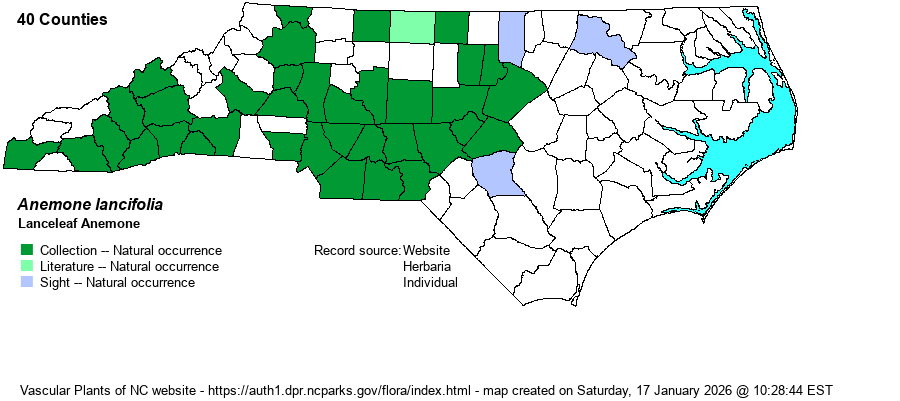| Author | Pursh | |
| Distribution | Present over essentially all of the Piedmont and Mountains, but seemingly absent in most of the northern Mountains. Ranges barely into the upper Coastal Plain, only along large brownwater rivers (i.e., the Roanoke and Cape Fear).
This species has a small range, centering on the southern Appalachians and adjacent Piedmont. It ranges north to WV, and south only to SC and eastern TN. | |
| Abundance | Despite its widespread occurrence over two provinces, it is generally only infrequent in the Mountains and Piedmont, seldom common anywhere. Rare to absent in the higher elevations (above perhaps 3,000 feet), and rare in the upper Coastal Plain along brownwater rivers. | |
| Habitat | This is a species of rich hardwood forests, usually where there is a great array of wildflowers. Usually these are in Basic Mesic Forests or Rich Cove Forests, but also can be found in the richer portions of Mesic Mixed Hardwood Forests. It may be found in rich bottomland forests, as well. | |
| Phenology | Blooms from March to May, and fruits shortly after flowering. | |
| Identification | This is a rather small and delicate herb, one of the classic "spring wildflowers" of hardwood forests. It grows only to about 6-8 inches tall. It has a few basal leaves that are deeply cleft into 3 sections, with serrated margins; each section is ovate and about 2 inches long. Near the top of the stem is a similar set of a few (2-3) leaves, again strongly cleft into 3 sections, somewhat smaller than the basal leaves. At the top of the stem, perhaps 2-3 inches above the upper set of leaves, is the single flower, consisting of 5 white sepals -- elliptic with rounded tips -- that yield a flower about 1.3 inches across. The quite similar A. quinquefolia is mainly a montane one, but both can occur together there; that species has basal and stem leaves deeply cleft as well, but with the general appearance of 5 sections/lobes rather than 3 -- though many plants will look like 3 with a partial cleft in the lateral sections. A. lancifolia normally has the lateral sections not at all partially or deeply cleft. Weakley (2018) points out additional, and probably stronger, characters: A. lancifolia has the terminal leaflet/segment lanceolate or ovate (broadest at or below the middle) and serrated on the margin to below the middle, and the sepals at least 15 mm (3/5-inch) long, producing a flower about 1.3-inch across. A. quinquefolia has leaflets broadest at or above the middle (elliptic, oblanceolate, or obovate), serrated only above the middle, and sepals less than 15 mm (3/5-inch) long. For whatever reason, this species often "has trouble" flowering, and many a spring walk in rich woods produces vegetative plants without flowers. And, in such a condition, the species can look quite a bit like a number of others, including one or more buttercups (Ranunculus spp.). Thus, you may need to see plants in bloom to be sure you have found this species. It does grow in sizable patches, as opposed to singly, so when a patch is in bloom, the forest floor lights up in bright white blooms (as well as with other wildflower species in bloom nearby). | |
| Taxonomic Comments | Some reference did, and still do, consider this species as a variety of A. quinquefolia, as A. quinquefolia var. lancifolia.
| |
| Other Common Name(s) | Mountain Thimbleweed | |
| State Rank | S4 | |
| Global Rank | G5 | |
| State Status | | |
| US Status | | |
| USACE-agcp | | |
| USACE-emp | | |

